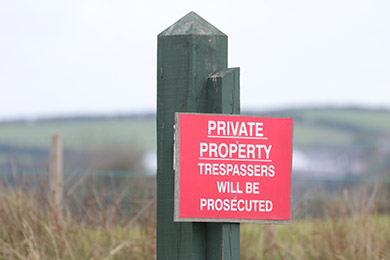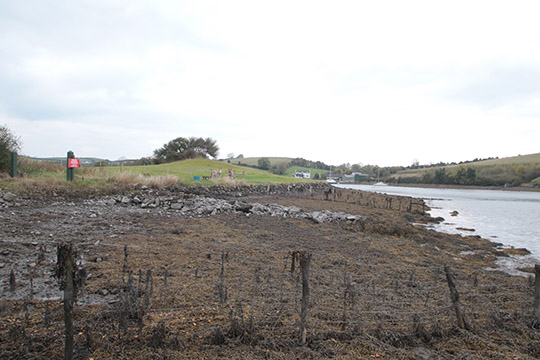A dispute between neighbours over a path which runs for about a half mile between Ringhaddy Road and the Quarterland Road at Killinichy has come to a head at a special meeting called by Newry Mourne and Down Distict Council.
The meeting was an opportunity for the disputing sides of Mr Canning, the majority landowner who maintains there is no public right of way, and the Ringhaddy Residents Association representing the path users and neighbours, to air their respective positions and for the Councillors in the chamber to decide on the evidence presented if the decision of the former legacy Down Distict Council was in fact legal and correct. Both parties were allowed a ten minute presentation on their positions.

Marie Ward, the Director of Enterprise Regeneration and Tourism for Newry Mourne and Down District Council explained that “the path running between Ringhaddy Road and the Quarterland Road at Killinchy was investigated by the legacy Down District Council officers and substantial evidence gathered which satisfied the Council’s legal advisers that a public right of way existed at this location.
“Subsequently, a public right of way was asserted by the former legacy Down District Council on the 23 February 2015.
“However, prior to the assertion of the public right of way, the Ringhaddy end of the path was blocked by the majority landowner who had disputed the existence of a public right of way.
“The landowner’s solicitor served a Judicial Review pre-action protocol letter on the Council in April 2015 on the basis that Council had not considered all the available evidence and submitted additional evidence on behalf of the objecting landowner.”
In looking at the key issues involved, Marie Ward said: “The Council has a statutory obligation under Article 3 (1) of the Access to the Countryside (NI) Order 1083 to ‘assert, protect and keep open and free from obstruction or encroachment any public right of way‘.
“The majority-landowner (Mr Canning) has objected to this assertion of the public right of way and the subject-path has been blocked.
“Council’s solicitor has therefore considered the additional advice and has recommended a Special Meeting of Council to be convened top hear deputations from the parties and consider if there is anything in additional evidence that would lead to Council changing its decision.”
First up was Mr Canning’s representative, Frank O’Donaghue of Peter Bowles Solicitors, who said that the Council had ‘misunderstood its statutory remit’ and that the Council could not ‘assert’ a public right of way, but that was a matter for the Courts. He added that no evidence of a public right of way existed and referred to a previous 9-point letter on this matter.
He also said that a public right of way must be complete and be between two points and he referred to a barbed wired fence and a jetty that had obstructed this. Mr O’Donaghue added that Council must recognise the cost of such an action in Court to assert a public right of way. He also indicated that this issue had blighted (the majority landowner’s) Mr Canning’s land and development potential.

First speaking for the Ringhaddy Resident’s Association was Jayne Young who said: “We are supported by the Ulster Federation of Rambling Clubs and and the Countryside Access Officer and have a wide body of evidence that a public right of way exists.
“My own personal recollection is in the 1950’s, we lived in a cottage at 44 Ringhaddy Road there and sailed, fished and swam on the beach and used this right of way constantly as did other people. I still visit friends there. I can remember then many cars coming to the Quarterland Road and families enjoying their picnics.
“The Resident’s Group is supported in this case by Jim Shannon MP who could not attend the meeting this evening.
“It is very frustrating that access to this path has been denied. I am at a loss as to how this can be.”
The second speaker for the Ringhaddy Residents’Association was Charles Paine who has flown in specially from his retirement home in Valencia in Spain. Mr Paine said: “I lived on the Quarter Road from 1939 to 1960 and on the Ringhaddy Road until 1970. My father sold the land to the Clarke family and the present landowner bought the land in 2011.
“In my personal opinion, it is highly unlikely that my father would have denied the existence of a public right of way to the new owner. This road was used for accessing the old quay, and it was used by the postman, and also to drive cattle on. It was never blocked. It is a well known track on the top of the sea shore.
“The old Urban Council even maintained the old stone walls and the road surface. And on many occasions a local priest would have tethered this trap there and gone swimming. At no time was there a gate on the road and it was never obstructed.”
Following the presentations, the Council went ‘into committee’ and members of the public and press had to step outside the chamber.
After a lengthy discussion, they were all called back in to the Council chamber and the Council Chairperson Councillor Gillian Fitzpatrick read out the decision of the Council. Of those Councillors present and voting, there were 12 for, none against with one abstention.
The Chairperson gave the Council’s position by saying: “The Council reconfirms the decision of the legacy Council to assert the public right of way, however, in light of the evidence that has been submitted by the landowner, the Council believes it would be prudent to seek a declaration in the High Court as to the status of the pathway.”
The matter will now be referred to the Courts to make a final decision on, but the Council is adamant that its position is the correct one based on the evidence presented to the legacy Council and in the recent inquiry on this public right of way issue.

























